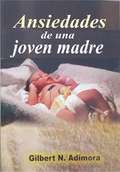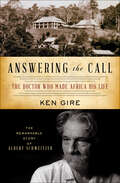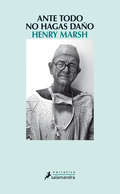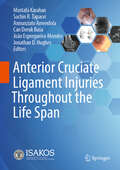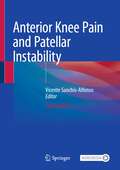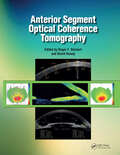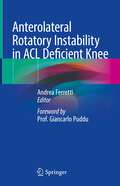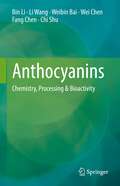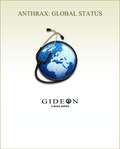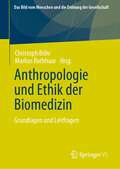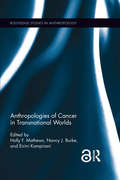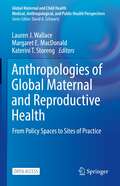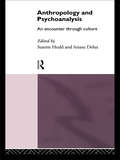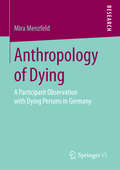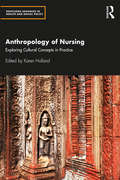- Table View
- List View
Ansiedades de una joven madre
by Itaipu Moreno Dr Gilbert AdimoraEste libro está pensado para ayudar a las madres, sobre todo primerizas. Su propósito es aliviarles de cualquier estrés o ansiedad provocado durante el embarazo, parto y posteriormente, cuando los bebés han nacido. Este libro se basa principalmente en la experiencias del doctor en Nigeria.
Answering the Call: The Doctor Who Made Africa His Life: The Remarkable Story of Albert Schweitzer
by Ken GireA Christian author’s inspiring biography of the Nobel Peace Prize–winning theologian and physician who built a hospital in French Equatorial Africa.As a young man, Albert Schweitzer seemed destined for greatness. His immense talent and fortitude drove him to become one of twentieth century Europe’s most renowned philosophers, theologians, and musicians. Yet Schweitzer shocked his contemporaries by forsaking worldly success and embarking on an epic journey into the wilds of French Equatorial Africa, vowing to serve as a lifelong physician to “the least of these” in a land rife with famine, sickness, and superstition.Schweitzer was honored with a Nobel Peace Prize in 1952. His legacy endures in the thriving African hospital community that began in a chicken coop, the millions who have drawn inspiration from his example, and the timeless wisdom and compassion of his writings. In this vividly narrated biography, Ken Gire sheds new light on Schweitzer’s faith-in-action ethic and his commitment to honor God by celebrating the sacredness of all life.
Ante todo, no hagas daño
by Henry MarshUn libro que ha cautivado y conmovido a crítica y público. Henry Marsh, el eminente neurocirujano británico expone a ojos del mundo la esencia de una de las especialidades médicas más difíciles, delicadas y fascinantes que existen. El resultado es este volumen que poco tiempo después de su publicación se encaramó a las listas de más vendidos del Sunday Times y el New York Times. Escogido «Mejor Libro del Año» por el Financial Times y The Economist, obtuvo los premios PEN Ackerley y South Bank Sky Arts y fue finalista del Costa Book Award, el Guardian First Book Award y el Samuel Johnson de no ficción. A los mandos de un microscopio ultrapotente y un catéter de alta precisión, el doctor Marsh se abre camino por los intersticios del cerebro. Con frecuencia, de su pericia y de su pulso dependen que un paciente recupere la visión oacabe en una silla de ruedas. Hay días en los que salva vidas, pero también hay jornadas nefastas en las que un pequeño error o una cadena de infortunios lo hacen sentirse el ser más desdichado sobre la faz de la Tierra. Mucho más cercano a una confesión personal que a una autobiografía complaciente con el autor, este libro -cuyo título se inspira en el juramento hipocrático- supone un auténtico alarde de valentía y de honestidad intelectual, un relato vibrante y luminoso que logra remover nuestros sentimientos más profundos y ensanchar nuestro umbral de sabiduría y compasión. Reseñas:«La neurociencia ha encontrado a su Boswell en Henry Marsh. Dolorosamente honesto sobre los errores que pueden "destrozar" un cerebro, exquisitamente sintonizado con el vínculo tenso y efímero entre médico y paciente, hilarantemente irritable ante la gestión hospitalaria, Marsh nos sumerge en el arte más difícil de la medicina y nos levanta el ánimo. Un logro soberbio.»Ian McEwan «Increíblemente absorbente [...]. Una visión tan sincera que sorprende y asombra.»Bill Bryson «El doctor Marsh revisa su vocación de una forma íntima, compasiva y, a ratos, aterradora.»Michiko Kakutani, The New York Times «Ante todo, no hagas daño es un conjunto de elegantes reflexiones al final de una larga carrera. Algunas de las historias son lo bastante emotivas como para llevarnos hasta las lágrimas [...]. En el fondo, éste es un libro acerca de la sabiduría y la experiencia.»The Telegraph
Antenatal Disorders for the MRCOG and Beyond
by Anumba, Dilly and Jivraj, Shehnaaz Dilly Anumba Shehnaaz JivrajDuring pregnancy, most women remain well and require little formal medical input, while a much smaller group develop complications with significant morbidity and mortality for their baby and, occasionally, for themselves. Providers of antenatal care must be able to distinguish between these two groups of women and arrange with them an appropriate and personalised plan of care. This book covers all aspects of identifying and caring for women who develop disorders during their pregnancies. This second edition has been comprehensively updated to reflect changes in clinical practice and new research since publication of the previous edition. The contents take into account that care of such women is provided by multidisciplinary teams of physicians, obstetricians, general practitioners and midwives.
Antenatal Midwifery Skills: Survival Guide (Nursing and Health Survival Guides)
by Alison EdwardsThis pocket-sized book, presented in an easy-to-follow format, is designed as a tool for students and professionals to carry in any setting, providing a quick reference guide to antenatal care and related anatomy and physiology. Used as a platform for wider reading, this text is an ideal reference point for any student or professional involved with the care of childbearing women.
Anterior Cruciate Ligament Injuries Throughout the Life Span
by Mustafa Karahan João Espregueira-Mendes Annunziato Amendola Sachin R. Tapasvi Can Doruk Basa Jonathan D. HughesThis book uniquely addresses anterior cruciate ligament (ACL) injury – one of the leading issues in orthopedic sports medicine – throughout the lifespan, with a focus on differences depending on age and activity levels.It provides readers with fundamental knowledge, such as anatomy histology and biomechanics, as well as with diagnostic criteria specific for each age group and activity level – from pediatrics through adolescents to adults and high-level athletes. Furthermore, international experts present diverse prevention and injury management criteria as well as state-of-the-art surgical techniques based on the expectations of each age and lifestyle group. Designed to be an easy-to-read reference guide, this book presents fundamental concepts in the management of ACL injuries. It appeals to a broad readership ranging from orthopedic surgeons, residents and sports physicians to athletic trainers and all professionals involved in rehabilitation following ACL injuries.
Anterior Cruciate Ligament Reconstruction: A Practical Surgical Guide
by Stefano Zaffagnini David Dejour Rainer SieboldThis practical and instructional guidebook, written by international experts in anterior cruciate ligament (ACL) reconstruction, covers all challenging aspects of ACL rupture in the acute and chronic setting. It covers the latest, spectacular anatomical findings, treatment of partial ACL tears, various techniques for single- and double-bundle ACL reconstruction, and complex ACL revision surgery. Important surgical steps are clearly described with the help of instructive, high-quality photographs. Important tips, tricks, and pitfalls are highlighted and intra- and postoperative complications, rehabilitation, and prevention of re-rupture are discussed. All authors are prominent and experienced ACL surgeons.
Anterior Hip Replacement: From Origin to Current Advanced Techniques
by Joel M. Matta Alexander P. SahAnterior hip replacement is a surgical approach that has dramatically changed the landscape of modern hip replacement. The approach is common to orthopedic trauma surgery, but it has been rapidly adopted in recent years for hip replacement as well. Its proposed benefits as a muscle-sparing surgery include less tissue trauma, faster recovery, and fewer hip precautions. While the technique can be challenging during initial learning and early adoption, the approach continues to increase in utilization in the U.S. every year because of these benefits. Understanding the initial development of the anterior surgical approach for hip replacement creates the foundation to better understand its modern clinical benefits and possibilities with advanced techniques. Furthermore, a detailed description of the reasoning behind the continued developments of the anterior approach helps in understanding the key elements needed to obtain the most successful outcomes.With the continued adoption of this technically challenging technique, there is a need for a comprehensive resource for newly adopting surgeons and surgeons in training, but also for experienced surgeons looking to enhance their skill sets. Written by experts in the field, this book presents the tips and tricks learned after years of experience by a wide spectrum of surgeons. Parts 1 and 2 describe the origin and background of the anterior approach for hip replacement, with early lessons learned, important tips when training others, and how to master the operating table and c-arm. Parts 3 and 4 cover hip biomechanics and variations on techniques and technologies, respectively, while part 5 is a unique compilation of surgeons' perspectives on managing common aspects of the approach. Revision surgery is described in part 6, and future directions for the technique are discussed in part 7, along with emerging navigation and technologies.Every year, there is an increasing number of orthopedic surgeons learning and adopting the anterior hip approach who would benefit from the resources in this book, which will serve as a critical learning tool for training surgeons and also as the go-to reference for optimizing current use and advancing future possibilities of the approach.
Anterior Knee Pain and Patellar Instability
by Vicente Sanchis-AlfonsoA multitude of leading international authorities provide fresh insights and approaches for patient evaluation and treatment of Anterior knee pain syndrome and patellofemoral instability. Included are new chapters featuring clinical cases and detailed descriptions of the most important surgical techniques used for the knee extensor mechanism, each being described by the surgeon who developed it. The book is divided in four sections, the first section focuses on the etiopathogenic bases, the second section focuses on emerging technologies, the third section includes difficult clinical cases studied, and the fourth section provides a description of the most important surgical techniques for the knee extensor mechanism.
Anterior Knee Pain and Patellar Instability
by Vicente Sanchis-AlfonsoThis textbook provides an authoritative reference on one of the most problematic entities in the pathology of the knee. Throughout the text, esteemed international experts highlight their clinical insights for ensuring optimal non-surgical and surgical outcomes when treating anterior knee pain and patellar instability. The chapters are revised with the latest updates and new chapters are featured focusing upon robotic-assisted patellofemoral replacement, predictive diagnostic models in anterior knee pain patients based on artificial intelligence, brain network functional connectivity in anterior knee pain patients, and many other hot topics in the field. Anterior Knee Pain and Patellar Instability, 3rd Edition is an essential, multi-disciplinary textbook for all levels of orthopedic surgeons, physiotherapists, radiologists, biologists, pathologists, and bioengineers, who wish to learn more about this complex pathology that affects both young and older patients.
Anterior Segment Optical Coherence Tomography
by David Huang Roger SteinertHigh-speed anterior segment optical coherence tomography (OCT) offers a non-contact method for high resolution cross-sectional and three-dimensional imaging of the cornea and the anterior segment of the eye. As the first text completely devoted to this topic, Anterior Segment Optical Coherence Tomography comprehensively explains both the scientific principles and the clinical applications of this exciting and advancing technology.Anterior Segment Optical Coherence Tomography enhances surgical planning and postoperative care for a variety of anterior segment applications by expertly explaining how abnormalities in the anterior chamber angle, cornea, iris, and lens can be identified and evaluated using the Visante OCT™.Inside Anterior Segment Optical Coherence Tomography, Dr. Roger Steinert and Dr. David Huang, along with 22 of the field's leading professionals, provide a wealth of useful clinical and physiological material about this new diagnostic imaging technique. Valuable images are included to assist in the pre- and postoperative assessment of various anterior segment disorders. Additionally, this unique resource contains detailed information on biometric measurements to enhance diagnostic capability.On the leading edge of anterior segment imaging: Mapping of corneal thickness and keratoconus evaluation Measurement of LASIK flap and stromal bed thickness Visualization and measurement of anterior chamber angle and diagnosis of narrow angle glaucoma Measuring the dimensions of the anterior chamber and assessing the fit of intraocular lens implants Visualizing and measuring the results of corneal implants and lamellar procedures Imaging through corneal opacity to see internal eye structures With the increase in popularity of anterior chamber imaging, and anterior segment OCT proving to be the best tool for high resolution biometry, Anterior Segment Optical Coherence Tomography is a must-have for anterior segment, refractive, cornea, and glaucoma surgeons.
Anterolateral Rotatory Instability in ACL Deficient Knee
by Andrea FerrettiThis book comprehensively discusses anterolateral rotatory instability in the ACL deficient knee, exploring anatomy, biomechanics, diagnostics, clinics, surgical techniques as well as short and long term outcomes. The author also offers an historical perspective ranging from the birth of modern anterior cruciate ligament surgery to the renewed global interest towards the role of secondary restraints and extra-articular reconstructions. Step-by-step guidance throughout each surgical technique further equips the reader to handle this complex condition. Covering all theoretical and practical aspects, as well as future perspectives, this book is a must-read for all orthopedic surgeons and sports physicians wanting to gain insights into this promising field.
Anthocyanins: Chemistry, Processing & Bioactivity
by Bin Li Fang Chen Wei Chen Li Wang Weibin Bai Chi ShuThis book summarizes the current knowledge of anthocyanins, provides systematic information for future exploration of anthocyanin applications. It focuses on several aspects regarding the studying progression in the field of anthocyanins. The first section of the book provides a brief introduction to the scope and progress on anthocyanins, which is followed by the second section that describes the natural sources, structure, extraction approaches, bioavailability, and current stabilizing approach of anthocyanins. Then in the third part, the book focuses on the industrial processing of anthocyanins in foods by discussing the impact of food processing on anthocyanin structure and composition as well as classical processing techniques on anthocyanin-containing foods, including high-pressure, encapsulation, microwave, and combined application of the above techniques. In the last section of the book, the authors explore the currently most popular application of anthocyanins in improving human health, such as the effect of anthocyanin on vision, metabolism, neural system, cardiovascular system, and cancers. The book will facilitate readers’ understanding of the progress of anthocyanin studies. And it will benefit researchers and graduate students in the fields of natural products, functional food, and nutrition, etc.
Anthony Cerami: A Life in Translational Medicine
by Conrad KeatingSince the turn of the new millennium, ‘translational research’, the scientific process of bringing disease-targeted knowledge from the laboratory to treat patients in the clinic, has gone mainstream and is now practiced by large universities and institutes across the globe. Into this dynamic of the rapidly changing world of translational medical research this book sets the life of one of the discipline’s most influential practitioners, Anthony Cerami. His work spans more than five decades and culminated in the discovery, invention and development of diagnostics and therapeutics used daily by millions of people. Students in molecular medicine and investigators pursuing basic science in the hope of improving human health will find inspiration in examining the sacrifices and achievements of Cerami’s career in translational medicine. During his three decades at Rockefeller University his cross-disciplinary and laboratory-without-wall approach established ‘rational drug design’ as the most effective means of advancing the fields of parasitology, hematology, immunology, metabolism, therapeutics and molecular medicine. Cerami’s story and that of the evolution of translation are intimately entwined: the contours of Cerami’s career shaped by developments in translation, and in exchange, the field itself molded by Cerami’s work. To understand one is to understand the other. By examining the life of this often overlooked biochemist it is possible to intimately focus on the ideas and thought processes of a scientist who has helped to define the great acceleration in translational research over the past half century – research that, knowingly or otherwise, has most likely affected the life of almost everyone on the planet. We also gain a better understanding of the febrile creative atmosphere that percolated through the laboratories leading the way in translational medicine, and gain insight into the art, science, successes, failures and providence that underlie major scientific breakthroughs. Anybody interested in the questions of where modern medicines come from, how health outcomes around the globe are affected by research and imagination, and where the future of drug discovery is leading, will be rewarded by exploring Cerami’s life in translation. This book is not restricted to those with a professional interest in science, because anyone dedicated to living a life of creativity and discovery will be rewarded by reading this book. In many respects, Cerami’s life reflects the modern metaphor of the ‘American dream’ with his journey from humble beginnings on a chicken farm in rural New Jersey, to occupying a place in the highest echelons of the US scientific establishment. His journey in translational medicine was propelled forward by two obsessions; the idea that he could help people who were sick, and the excitement of discovery. In following his two great passions, he trained a generation of specialists in translational medicine that continue to transform our understanding of, and treatments for, human disease. Anthony Cerami’s work has shown how science has become an important force for social change by laying the foundations of modern translational medicine.
Anthrax: Global Status 2010 edition
by Dr Stephen Berger Gideon InformaticsAnthrax: Global Status is one in a series of GIDEON ebooks which summarize the status of individual infectious diseases, in every country of the world. Data are based on the GIDEON database (www.gideononline.com) which relies on standard text books, peer-review journals, Health Ministry reports and ProMED, supplemented by an ongoing search of the medical literature. Chapters are arranged alphabetically, by country name. Each section is divided into six subsections. 1. Descriptive epidemiology 2. Summary of clinical features 3. Global status of the disease4. Potential use in Bioterrorism 5. Status of the disease in a specific country 6. References
Anthropological Perspectives on Tooth Morphology
by G. Richard Scott Joel D. IrishResearchers have long had an interest in dental morphology as a genetic proxy to reconstruct population history. Much interest was fostered by the use of standard plaques and associated descriptions that comprise the Arizona State University Dental Anthropology System, developed by Christy G. Turner, II and students. This system has served as the foundation for hundreds of anthropological studies for over 30 years. In recognition of that success, this volume brings together some of the world's leading dental morphologists to expand upon the concepts and methods presented in the popular The Anthropology of Modern Human Teeth (Cambridge University Press, 1997), leading the reader from method to applied research. After a preparatory section on the current knowledge of heritability and gene expression, a series of case studies demonstrate the utility of dental morphological study in both fossil and more recent populations (and individuals), from local to global scales.
Anthropologie und Ethik der Biomedizin: Grundlagen und Leitfragen (Das Bild vom Menschen und die Ordnung der Gesellschaft)
by Christoph Böhr Markus RothhaarIn bioethische Kontroversen geht es zumeist um den Umgang des Menschen mit sich selbst, genauer: den Umgang mit den biologischen Grundlagen seiner – der menschlichen – Existenz. Bioethik verweist darum immer auch auf den Begriff des Menschen und damit auf die philosophische Anthropologie. Diese anthropologische Dimension der Bioethik bleibt allerdings oft unausgesprochen und unreflektiert. Der vorliegende Band versucht diese Lücke zu schließen, indem er die Bioethik, sowohl in den Grundlagen, als auch in der Behandlung konkreter Fragestellungen, von der Embryonenforschung und der Reproduktionsmedizin über die Gentechnologie und den sogenannten Transhumanismus bis hin zur Sterbebegleitung, konsequent vom Begriff des Menschen her zu denken versucht.
Anthropologies of Cancer in Transnational Worlds (Routledge Studies in Anthropology)
by Holly F. Mathews Nancy J. Burke Eirini KamprianiCancer is a transnational condition involving the unprecedented flow of health information, technologies, and people across national borders. Such movement raises questions about the nature of therapeutic citizenship, how and where structurally vulnerable populations obtain care, and the political geography of blame associated with this disease. This volume brings together cutting-edge anthropological research carried out across North and South America, Europe, Africa and Asia, representing low-, middle- and high-resource countries with a diversity of national health care systems. Contributors ethnographically map the varied nature of cancer experiences and articulate the multiplicity of meanings that survivorship, risk, charity and care entail. They explore institutional frameworks shaping local responses to cancer and underlying political forces and structural variables that frame individual experiences. Of particular concern is the need to interrogate underlying assumptions of research designs that may lead to the naturalizing of hidden agendas or intentions. Running throughout the chapters, moreover, are considerations of moral and ethical issues related to cancer treatment and research. Thematic emphases include the importance of local biologies in the framing of cancer diagnosis and treatment protocols, uncertainty and ambiguity in definitions of biosociality, shifting definitions of patienthood, and the sociality of care and support. Chapter 3 of this book is freely available as a downloadable Open Access PDF at www.tandfebooks.com/openaccess. It has been made available under a Creative Commons Attribution-Non Commercial-No Derivatives 3.0 license.
Anthropologies of Global Maternal and Reproductive Health: From Policy Spaces to Sites of Practice (Global Maternal and Child Health)
by Lauren J. Wallace Margaret E. MacDonald Katerini T. StorengThis open access edited book brings together new research on the mechanisms by which maternal and reproductive health policies are formed and implemented in diverse locales around the world, from global policy spaces to sites of practice. The authors – both internationally respected anthropologists and new voices – demonstrate the value of ethnography and the utility of reproduction as a lens through which to generate rich insights into professionals’ and lay people’s intimate encounters with policy. Authors look closely at core policy debates in the history of global maternal health across six different continents, including: Women’s use of misoprostol for abortion in Burkina FasoThe place of traditional birth attendants in global maternal healthDonor-driven maternal health programs in TanzaniaEfforts to integrate qualitative evidence in WHO maternal and child health policy-making Anthropologies of Global Maternal and Reproductive Health will engage readers interested in critical conversations about global health policy today. The broad range of foci makes it a valuable resource for teaching in medical anthropology, anthropology of reproduction, and interdisciplinary global health programs. The book will also find readership amongst critical public health scholars, health policy and systems researchers, and global public health practitioners.
Anthropology and Psychoanalysis: An Encounter Through Culture
by Suzette Heald Ariane DeluzIn Anthropology and Psychoanalysis the contributors, both practising anthropologists and psychoanalysts, explore in detail the interface between the two disciplines and locate this within the history of both anthropology and psychoanalysis. In particular, they deal with the distinctive reactions of British, French and American anthropology to psychoanalysis and the way in which the present fracturing of each of these national traditions and their post-modern turn has led to a new willingness to investigate the relationships between the disciplines and the role of the unconscious in cultural life. They also address important issues of methodology, and present a critical discussion of the concept of culture and the academic specialisation of knowledge. Anthropology and Psychoanalysis will be invaluable reading to all anthropologists and psychoanalysts.
Anthropology in Medical Education: Sustaining Engagement and Impact
by Iveris L. Martinez Dennis W. WiedmanThis volume reflects on how anthropologists have engaged in medical education and aims to positively influence the future careers of anthropologists who are currently engaged or are considering a career in medical education. The volume is essential for medical educators, administrators, researchers, and practitioners, those interested in the history of medicine, global health, sociology of health and illness, medical and applied anthropology. For over a century, anthropologists have served in many roles in medical education: teaching, curriculum development, administration, research, and planning. Recent changes in medical education focusing on diversity, social determinants of health, and more humanistic patient-centered care have opened the door for more anthropologists in medical schools. The chapter authors describe various ways in which anthropologists have engaged and are currently involved in training physicians, in various countries, as well as potential new directions in this field. They address critical topics such as: the history of anthropology in medical education; humanism, ethics, and the culture of medicine; interprofessional and collaborative clinical care; incorporating patient perspectives in practice; addressing social determinants of health, health disparities, and cultural competence; anthropological roles in planning and implementation of medical education programs; effective strategies for teaching medical students; comparative analysis of systems of care in Japan, Uganda, France, United Kingdom, Mexico, Canada and throughout the United States; and potential new directions for anthropological engagement with medicine. The volume overall emphasizes the important role of anthropology in educating physicians throughout the world to improve patient care and population health.
Anthropology of Dying: A Participant Observation with Dying Persons in Germany
by Mira MenzfeldMira Menzfeld explores dying persons' experiences of their own dying processes. She reveals cultural specificities of pre-exital dying in contemporary Germany, paying special attention to how concepts of dying '(un)well' are perceived and realized by dying persons. Her methodological focus centers on classical ethnographic approaches: Close participant observation as well as informal and semi-structured conversations. For a better understanding of the specificities of dying in contemporary Germany, the author provides a refined definition catalogue of adequate terms to describe dying from an anthropological perspective.
Anthropology of Nursing: Exploring Cultural Concepts in Practice
by Karen HollandThis book aims to introduce nurses and other healthcare professionals to how anthropology can help them understand nursing as a profession and as a culture. Drawing on key anthropological concepts, the book facilitates the understanding and critical consideration of nursing practice, as seen across a wide range of health care contexts, and which impacts the delivery of appropriate care for service users. Considering the fields in which nurses work, the book argues that in order for nurses to optimize their roles as deliverers of patient care, they must not only engage with the realities of the cultural world of the patient, but also that of their own multi-professional cultural environment. The only book currently in the field on anthropology of nursing, this book will be a valuable resource for nursing students at all academic levels, especially where they can pursue specific modules in the subject, as well as those other students pursuing medical anthropology courses. As well as this, it will be an essential text for those post-graduate students who wish to consider alternative world views from anthropology and their application in nursing and healthcare, in addition to their undertaking ethnographic research to explore nursing in all its fields of practice.
Anthropology of Tobacco [Open Access]: Ethnographic Adventures in Non-Human Worlds
by Andrew RussellTobacco has become one of the most widely used and traded commoditites on the planet. Reflecting contemporary anthropological interest in material culture studies, Anthropology of Tobacco makes the plant the centre of its own contentious, global story in which, instead of a passive commodity, tobacco becomes a powerful player in a global adventure involving people, corporations and public health. Bringing together a range of perspectives from the social and natural sciences as well as the arts and humanities, Anthropology of Tobacco weaves stories together from a range of historical, cross-cultural and literary sources and empirical research. These combine with contemporary anthropological theories of agency and cross-species relationships to offer fresh perspectives on how an apparently humble plant has progressed to world domination, and the consequences of it having done so. It also considers what needs to happen if, as some public health advocates would have it, we are seriously to imagine ‘a world without tobacco’. This book presents students, scholars and practitioners in anthropology, public health and social policy with unique and multiple perspectives on tobacco-human relations.
Anthropology of Violent Death: Theoretical Foundations for Forensic Humanitarian Action (Forensic Science in Focus)
by Roberto C ParraThe first book to specifically focus on the theoretical foundations of humanitarian forensic science Anthropology of Violent Death: Theoretical Foundations for Forensic Humanitarian Action consolidates the concepts and theories that are central to securing the posthumous dignity of the deceased, respecting their memories, and addressing the needs of the surviving populations affected. Focusing on the social and cultural significance of the deceased, this much-needed volume develops a theoretical framework that extends the role of humanitarian workers and specifically the actions of forensic scientists beyond an exclusively legal and technical approach. Anthropology of Violent Death is designed to inspire and alerts the scientific community, authorities, and the justice systems to think and take actions to avoid the moral injury in society and cultures due to grave disrespect against humanity, its memories and reconciliation. Humanitarian forensic science faces the role of mediator between the deceased and those who are still alive to guarantee the respect and dignity of humanity. Contributions from renowned experts address post-mortem dignity, cultural perceptions of violent death and various mortuary sites, the forms and critical effects of the so-called forensic turn and humanitarian action, the treatment of violent death in post-conflict societies, respect for the dead under International Humanitarian Law (IHL) and Islamic law, the ethical management of the death of migrants, and much more. In an increasingly violent world, this volume, develops a theoretical component for death management in scenarios where humanitarian action is required Facilities better understanding between the social sciences, the forensic sciences, and justice systems in situations involving violent death Discusses the latest theories from leading scholars and practitioners to enhance the activities of forensic scientists and authorities who have the difficult responsibility of making decisions It provides a better understanding of the humanitarian and cultural dilemmas in the face of violent death episodes, and the unresolved needs of the dignity of the deceased during armed conflicts, disasters, migration crises, including everyday homicides Anthropology of Violent Death: Theoretical Foundations for Forensic Humanitarian Action is an indispensable resource for forensic scientists, humanitarian workers, human rights defenders, and government and non-governmental officials.
